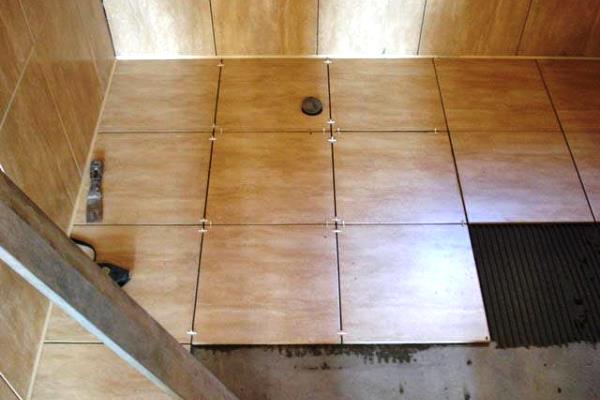Laying floor tiles with your own hands
Laying floor tiles with your own hands
Laying floor tiles is one of those types of repair that you can do yourself, without recourse to specialists.

For laying floor tiles we will need:- floor tiles in the right amount (calculated on the basis of the floor area plus a stock of 1.5 meters), - plinth, - tile cutter or grinder with a disc for cutting tiles, - tile glue, - grout for grouting joints, - remote plastic crosses, - tank for glue, - notched trowel, - rubber spatula, - rags, - hammer and chisel (for churning unevennesses), - level, - strong thread, - a bit of plasticine. The most important stage preceding the laying of floor tiles is the preparation of the floor surface. Naturally, all furniture must be removed, the old tiles - removed from the floor. The simplest and least labor-consuming variant of floor leveling is a cement screed. However, this type of work should be carried out only if the evenness of the floor causes too much suspicion. If the differences in height do not exceed a few millimeters, you can close your eyes on them, as they are smoothed with tile glue. Certain protrusions can be knocked down with a chisel and a hammer, and on grooves with a diameter of not more than 10 cm, one can not focus attention. The floor must be clean and free of dust and dirt before laying the floor tiles. It can also be pre-primed. Next, you need to mark out the floor for laying the floor tiles. To do this, you can take the floor tiles themselves and lay one row along and one - across the room. In this case, it is recommended to spread the tile not immediately close to the wall, but so that there is a small gap along the walls, that is, to make a gap. This is done in order to hide the possible unevenness of the walls, which can be seen when laying the tiles closely. If possible, the gaps around the perimeter should be the same. These gaps are subsequently filled with fragments of tiles. After laying and leveling two rows of tiles, you can pull two strands (along and across the room) respectively, fixing them to the walls with the help of plasticine or in another way. In the case where the walls or corners of the room are very uneven, the floor tiles can be laid diagonally. At the same time, the process of laying the tiles will be almost identical to the technology of laying floor tiles in the usual way. The only thing that is different is filling the gaps around the walls (more labor to cut out the necessary fragments). After marking the floor, you can mix the glue and start laying the floor tiles. The adhesive is applied with a notched trowel on either the tile itself or on the floor. The teeth on the spatula are needed in order to accurately measure the right amount of glue. The first floor tile is laid along the joint of the longitudinal and transverse threads and is slightly pressed down. The next tiles are stacked respectively in a row with the first, and so on until the end of the room. Between the adjacent tiles in the seams you need to insert plastic remote crosses. In this case, you can put them directly into the glue in the joint of four tiles or put vertically two pieces between the tiles. In the second case, after drying the glue, the cross should be removed. Crosses ensure the evenness of the seams and, accordingly, the entire masonry of the floor tiles. Horizontal flatness of the laying of floor tiles must be constantly checked by level and visually. If one tile is recessed in relation to the neighboring tiles, it must be carefully removed, add more glue and put it in its place. The final stage is filling the gaps around the perimeter of the room. If a Bulgarian is used, the respiratory organs should be protected from the ingress of ceramic dust. Tiles are cut with such a calculation that between it and the wall there is a small gap of 2-3 mm. Here you also need to use crosses on the above technology. After laying all the tiles and drying the glue sticking out the cross should be removed, and the seams between the tiles filled with fugue. Fugue is rubbed into the intertight seams using a rubber spatula, and its remnants are easily removed with a damp rag. After the fugue dries around the perimeter of the room, a plinth is installed, which is fixed to the walls and gives the floor a complete look.







